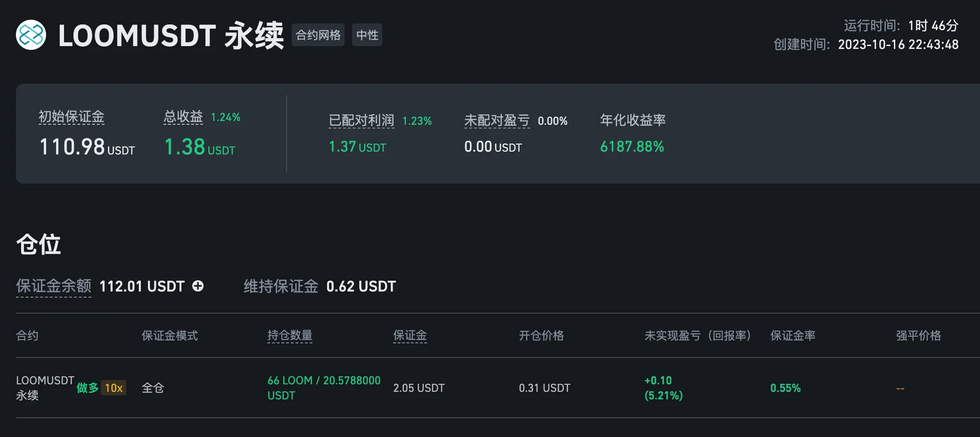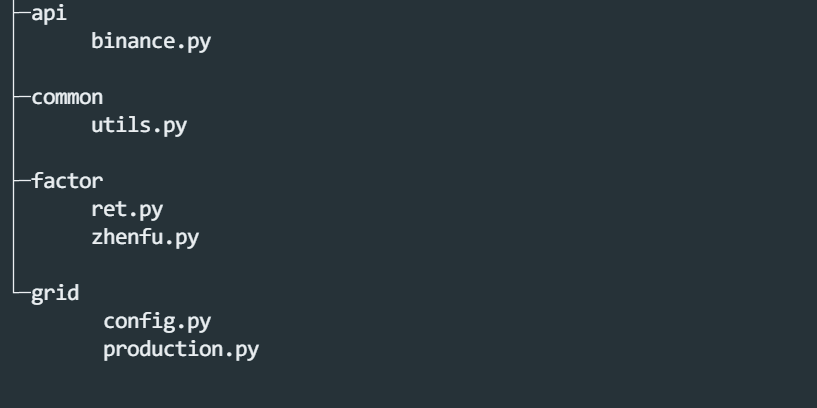1
2
3
4
5
6
7
8
9
10
11
12
13
14
15
16
17
18
19
20
21
22
23
24
25
26
27
28
29
30
31
32
33
34
35
36
37
38
39
40
41
42
43
44
45
46
47
48
49
50
51
52
53
54
55
56
57
58
59
60
61
62
63
64
65
66
67
68
69
70
71
72
73
74
75
76
77
78
79
80
81
82
83
84
85
86
87
88
89
90
91
92
93
94
95
96
97
98
99
100
101
102
103
104
105
106
107
108
109
110
111
112
113
114
115
116
117
118
119
120
121
122
123
124
125
126
127
128
129
130
131
132
133
134
135
136
137
138
139
140
141
142
143
144
145
146
147
148
149
150
151
152
153
154
155
156
157
158
159
160
161
162
163
164
165
166
167
168
169
170
171
172
173
174
175
176
177
178
179
180
181
182
183
184
185
186
187
188
189
190
191
192
193
194
195
196
197
198
199
200
201
202
203
204
205
206
207
208
209
210
211
212
213
214
215
216
217
218
219
220
221
222
223
224
225
226
227
228
229
230
231
232
233
234
235
| import json
import math
import time
import traceback
from datetime import timedelta
import ccxt
import pandas as pd
from tqdm import tqdm
from common.utils import retry_wrapper
exchange = ccxt.binance()
exchange.https_proxy = 'http://127.0.0.1:7890/'
exchange.timeout = 3000
def fetch_account_balance(enable_retry=False):
account_data = retry_wrapper(
exchange.fapiPrivateV2GetAccount,
func_name='fapiPrivateV2GetAccount',
enable_retry=enable_retry,
)
assets = pd.DataFrame(account_data['assets'])
return float(assets[assets['asset'] == 'USDT']['walletBalance'])
def fetch_positions(enable_retry=False):
position_data = retry_wrapper(
exchange.fapiPrivateV2GetPositionRisk,
func_name='fapiPrivateV2GetPositionRisk',
enable_retry=enable_retry,
)
df = pd.DataFrame(position_data)
columns = {
'positionAmt': '当前持仓量',
'entryPrice': '持仓均价',
'markPrice': '当前价格',
'unRealizedProfit': '持仓收益',
}
df.rename(columns=columns, inplace=True)
df = df.astype({
'当前持仓量': float,
'持仓均价': float,
'当前价格': float,
'持仓收益': float,
})
df = df[df['当前持仓量'] != 0]
df.set_index('symbol', inplace=True)
df = df[['当前持仓量', '持仓均价', '当前价格', '持仓收益']]
return df
def fetch_candle_data(symbol, end_time, time_interval, limit, enable_retry=False):
start_time_dt = end_time - pd.to_timedelta(time_interval) * limit
params = {
'symbol': symbol,
'interval': time_interval,
'limit': limit,
'startTime': int(start_time_dt.timestamp() * 1000)
}
try:
kline_data = retry_wrapper(
exchange.fapiPublicGetKlines,
params,
func_name='fapiPublicGetKlines',
enable_retry=enable_retry,
)
except Exception as e:
print(traceback.format_exc())
return pd.DataFrame()
df = pd.DataFrame(kline_data).astype(float)
columns = {
0: 'candle_begin_time',
1: 'open',
2: 'high',
3: 'low',
4: 'close',
5: 'volume',
6: 'close_time',
7: 'quote_volume',
8: 'trade_num',
9: 'taker_buy_base_asset_volume',
10: 'taker_buy_quote_asset_volume',
11: 'ignore',
}
df.rename(columns=columns, inplace=True)
df['symbol'] = symbol
df.sort_values(by=['candle_begin_time'], inplace=True)
df.drop_duplicates(subset=['candle_begin_time'], keep='last', inplace=True)
df.reset_index(drop=True, inplace=True)
return df
def fetch_all_candle_data(symbol_list, run_time, time_interval, limit, enable_retry=False):
symbol_candle_data = {}
for symbol in tqdm(symbol_list):
df = fetch_candle_data(symbol, run_time, time_interval, limit, enable_retry)
if df.empty:
continue
utc_offset = int(time.localtime().tm_gmtoff / 60 / 60)
df['candle_begin_time'] = pd.to_datetime(df['candle_begin_time'], unit='ms') + timedelta(hours=utc_offset)
df = df[df['candle_begin_time'] < run_time]
symbol_candle_data[symbol] = df
return symbol_candle_data
def fetch_ticker_price(enable_retry=False):
ticker_data = retry_wrapper(
exchange.fapiPublicGetTickerPrice,
func_name='fapiPublicGetTickerPrice',
enable_retry=enable_retry,
)
tickers = pd.DataFrame(ticker_data).astype({'price': float, 'time': float})
tickers.set_index('symbol', inplace=True)
return tickers['price']
def load_market():
exchange_data = retry_wrapper(
exchange.fapiPublicGetExchangeInfo,
func_name='fapiPublicGetExchangeInfo',
)
symbol_dict_list = exchange_data['symbols']
df_list = []
for symbol_info in symbol_dict_list:
symbol = symbol_info['symbol']
df_data = {
'symbol': symbol,
'onboardDate': int(symbol_info['onboardDate']),
'status': symbol_info['status'],
'quoteAsset': symbol_info['quoteAsset'],
'contractType': symbol_info['contractType'],
}
for _filter in symbol_info['filters']:
if _filter['filterType'] == 'PRICE_FILTER':
df_data['pricePrecision'] = int(math.log(float(_filter['tickSize']), 0.1))
if _filter['filterType'] == 'LOT_SIZE':
df_data['minQuantity'] = int(math.log(float(_filter['minQty']), 0.1))
if _filter['filterType'] == 'MIN_NOTIONAL':
df_data['minNotional'] = float(_filter['notional'])
df_list.append(df_data)
df = pd.DataFrame(df_list)
df.set_index('symbol', inplace=True)
return df
def place_order(symbol_order, symbol_market_info, enable_retry=False, enab
order_params = []
symbol_ticker_price = fetch_ticker_price(enable_retry)
for symbol, row in symbol_order.iterrows():
min_qty = symbol_market_info.at[symbol, 'minQuantity']
min_notional = symbol_market_info.at[symbol, 'minNotional']
price_precision = symbol_market_info.at[symbol, 'pricePrecision']
if pd.isna(min_qty) or pd.isna(min_notional) or pd.isna(price_precision) :
raise Exception('当前币种没有最小下单精度或者最小价格精度,币种信息异常')
quantity = row['实际下单量']
quantity = round(quantity, min_qty)
if quantity > 0:
side = 'BUY'
price = symbol_ticker_price[symbol] * 1.015
else:
side = 'SELL'
price = symbol_ticker_price[symbol] * 0.985
quantity = abs(quantity)
price = round(price, price_precision)
reduce_only = (row['交易模式'] == '清仓')
if quantity * price < min_notional:
if not reduce_only:
print(symbol, '交易金额小于最小下单金额,跳过该笔交易')
print('下单量: ', quantity, '价格: ', price, '最小下单金额: ', min_notional)
continue
params = dict()
params['symbol'] = symbol
params['type'] = 'LIMIT'
params['timeInForce'] = 'GTC'
params['newClientOrderId'] = str(time.time())
params['side'] = side
params['price'] = str(price)
params['quantity'] = str(quantity)
params['reduceOnly'] = str(reduce_only)
order_params.append(params)
print('每个币种的下单参数: ', order_params)
order_results = []
if not enable_place_order:
return order_params, order_params
for i in range(0, len(order_params), 5):
order_params = order_params[i:i+5]
try:
result = retry_wrapper(
exchange.fapiPrivatePostBatchOrders,
params={'batchOrders': json.dumps(order_params)},
func_name='fapiPrivatePostBatchOrders',
enable_retry=enable_retry,
)
print('批量下单完成,批量下单结果: ', result)
order_results += result
except Exception as e:
print(e)
continue
return order_params, order_results
|






